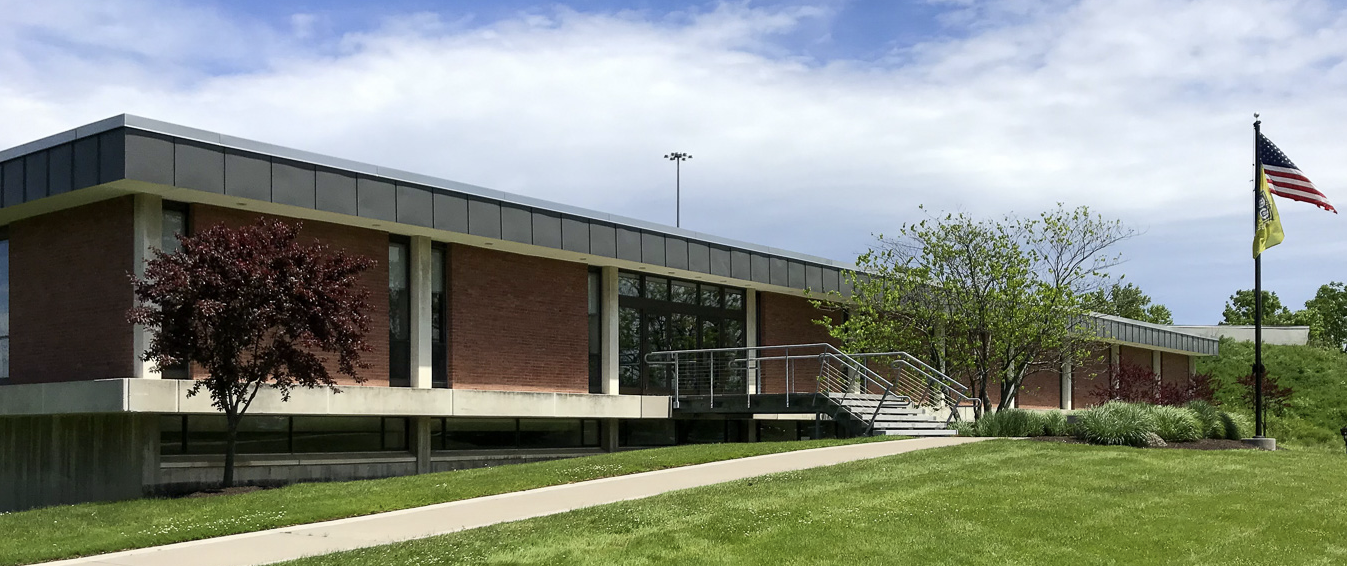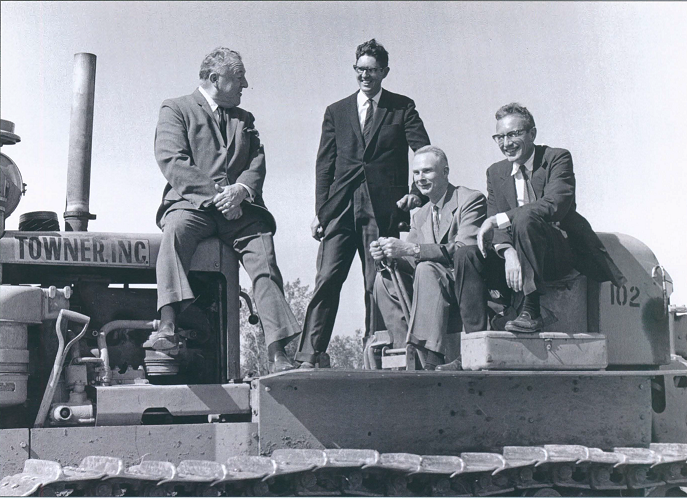
| South Campus | University Facilities Center |
 |
| University Facilities Center |
 |
| Manning the bulldozer at groundbreaking ceremonies for a nuclear
structure research laboratory are President Wallis (at the controls), trustee chairman Joseph C. Wilson '31 at right, and at left Rochester Gas & Electric CEO Robert Ginna and physics professor Harry Gove, from Beside the Genesee: a pictorial history of the University of Rochester, page 86. (2000) |
Ground was broken for a Nuclear Structure Research Laboratory on June 26, 1964 and the building was complete in late 1965. The Emperor tandem accelerator was installed in 1966 and the building was dedicated on June 1, 1967. The facility was largely funded by various agencies of the federal government and when this funding dried up the program evaporated sometime in the late 1990s.
The facility included a tandem Van de Graff accelerator, which was the state-of-the-art Emperor model, capable of accelerating high-resolution beams of helium-irons to energies of over 30 MeV and also an Enge split-pole magnetic spectrograph for high-resolution particle spectroscopy. In the 1980s the accelerator was upgraded to increase its terminal potential from approximately 12 MV to 18 MV.
Th3 accelerator was decommissioned in 1995 and moved to the Brookhaven National Laboratory to serve as a second injector to the new Relativistic Heavy Ion Collider (RHIC) facility.
The NSRL parking lot was used by undergraduates and the building is shown on some later campus maps as the Administrative Annex
The building was renovated to house University Facilities & Services, which moved from 612 Wilson Boulevard in June 2008.
References
1962 "Building and Grounds Gets New Name, New Look," University
Record. 2(8):1 (September 1962)
The name of the Department of Buildings and Grounds has been changed to
the Department of Physical Plant, and several new departmental
appointments made, according to Roger Austin, University architect.
James M. Young, general superintendent of Buildings and Grounds, is the
new superintendent of Physical Plant.
Named to the new post of assistant superintendent of Physical Plant for
engineering is James Dungan, formerly assistant chief engineer at the
Heating Plant. He will have responsibility for the continued mechanical
engineering work on the University physical plant, the heating plant as it
involves heating, electrical work, plumbing, ventilation and air
conditioning.
He will also be responsible for the control and coordination of mechanical
engineering as it applies to the new buildings being designed for the
River Campus. George Haas will continue as chief engineer of the Heating
Plant.
An appointment will be made in the future to the new post of assistant
superintendent of Physical Plant for Operations. This fall a new
department will be established for air-conditioning.
Arthur Hughston, former chief electrician, has been appointed to the
newly-created position of chief of electrical planning. He will devote his
time to the immediate and future needs of UR electrical installations.
Fred Curtis has been named new chief electrician.
1963 "UR Given Grant for
Nuclear Lab," University Record 3(1):1 (January 1963)
A $3,561,000 National Science Foundation grant—the largest single award
ever made by the Foundation —to the University toward the cost of a unique
laboratory to study the structure of atomic nuclei was announced Dec. 19
by W. Allen Wallis, University president. The grant includes $3,136,000
for a new accelerator and $425,000 to defray part of the cost of a
$1,743,000 laboratory.
1963 "Medical
Center at UR Given $3.1 Million Aid," Democrat and Chronicle,
October 12, 1963, Page 23.
Earlier, this year the UR received the largest grant ($3.5 million) ever
made by the National Science Foundation. That grant is for construction of
a nuclear structure research laboratory.
1954 "UR South Campus Construction Commences on $5.2 Million Nuclear Structure Lab," Campus Times, July 22, 1964, Page 1.
1966 "Emperor Opens New Chapter in UR History," University Record 6(7):4-5 (July-August 1966)
1967 "More
News about NRSL Dedication," Currents, May 26, 1967
The dedication ceremonies of the Nuclear Structure Research Laboratory on
the South Campus will begin at 10:30 a.m., Thursday, June 1.
1967 "UR to Dedicate Atom Laboratory," Democrat and Chronicle, June 1, 1967, Page 17.
1967 "Enter the Emperor," Rochester Review 29(2):10-14 (Winter 1967)
1977 "North-American
MP Tandem accelerators," by H. E. Wegner and Peter Thieberger
There are six North-American MP Tandem accelerators: Yale; Minnesota;
Chalk River; Rochester; and two at Brookhaven. The current status and
operating characteristics of these six tandem accelerators are discussed.
Upgrade and special improvements of the different machines is reviewed and
new developments since the last Electrostatic Conference are discussed in
detail. The overall operating characteristics of the different machines
during the last year of operation are compared.
1981 "The North-American MP Tandem accelerators," Nuclear Instruments and Methods 184:121-144 (1981)
1981 "NSRL Advances in Nuclear Physics," Campus Times, February 10, 1981, Page 3 | Part 2 |
1986 "John
Huizenga at the Nuclear Structure Research Lab. (NSRL), by Harry
Edmund Gove, Nuclear Fission and Heavy-ion-induced Reactions: Festschrift
and Proceedings of the International Symposium on Nuclear Fission and
Heavy-Ion-Induced Reactions Held on the Occasion of the 65th Anniversary
of the Birth of John R. Huizenga, University of Rochester, New York,
April 20-22, 1986, edited by Wolf-Udo Schröder.
The first experiments at the University of Rochester's Nuclear Structure
Research Laboratory were carried out in early November of 1966 and the
accelerator itself was officially accepted in April of 1967. The
laboratory's inception was a result of an idea of Robert Marshack and
Bruce French of the Department of Physics and Astronomy at Rochester. A
proposal was submitted to three federal agencies in February 1962. The
proposal was accepted by the latter organization, the National Science
Foundation and NSRL has flourished in nuclear science since that time.
This paper presents an overview of John Huizenga's activities at the NSRL
1989 "Time
Machine," Rochester Review 51(3):3-7 (Spring 1989)
Harry Gove's tandem accelerator, originally developed for pure research
into nuclear physics, has led him into some very strange places indeed
including a lO-year entanglement with the Shroud of Turin.
1989 "Progress in Radiocarbon Dating the Shroud of Turin," by Harry Edmund Gove, Radiocarbon 31(3):965-969 (1989)
1991 "Rochester Scientists to Build World's Best Neutron Detector," October 4, 1991
1992 "Radioactive clock helps unlock environmental secrets," November 2, 1992
2000 "Physicist Harry Gove unravels mysteries," Currents, February 7, 2000
2009 Five decades of research in nuclear science, by John R Huizenga
2010 "Obituary
of Harry Edmund Gove," Physics Today (July 19, 2000)
From 1964 onwards Gove directed the new Nuclear Structure Research
Laboratory at the University of Rochester as Professor of Physics. Over
the next decade this facilities was used for a wide range of nuclear
reaction studies and generated a wealth of new data which provided the
opportunity for extensive tests of model calculations for nuclei ranging
from the 1p shell to the actinides. During this period a program of
heavy-ion reaction studies was developed, together with a pulsed-beam
facility with sub-nanosecond resolution that was also brought into
operation
The
History of Nuclear Physics at the University of Rochester
The Nuclear Structure Research Laboratory was built on campus during the
early 1960s. It was centered on one of the worlds largest tandem Van de
Graaff accelerators which was equipped with a versatile arsenal of
instrumentation. This powerful heavy-ion beam facility was commissioned in
1966 and upgraded in the 1980s. For 29 years it played an important and
distinguished role in nuclear science, as well as pioneering new fields
such as accelerator mass spectrometry. This accelerator was decommissioned
in 1995 and moved to the Brookhaven National Laboratory to serve as a
second injector to the new RHIC facility.
© 2021 Morris A. Pierce